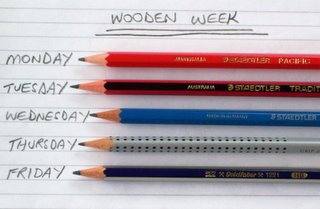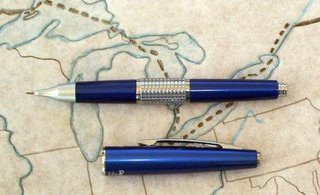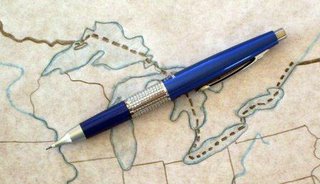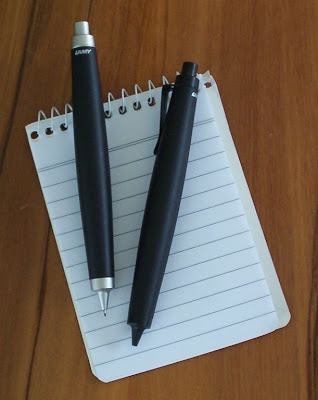Anyone visiting a selection of shops here in New Zealand would quickly get the impression that Staedtler was the market giant, with Faber-Castell a fairly distant second, and so I decided to trial three Staedtlers and two Faber-Castells.
I chose the following HB grade pencils as a reasonable selection of different price ranges, qualities and designs.
Monday - Staedtler (Australia) Pacific 830
Tuesday - Staedtler (Australia) Tradition 110
Wednesday - Staedtler Mars Lumograph 100 (Made in Germany)
Thursday - Faber-Castell Grip 2001 (Made in Germany)
Friday - Faber-Castell Goldfaber 1221 (Country of origin not identified)

Rather than a lengthy or formal review of these pencils I am just going to concentrate on some general points and a few selected issues. First is, I had forgotten just how loud wooden pencils are! Writing with them is really noisy compared to mechanical pencils. Amazing. The next thing is how important your choice of sharpener is to the whole situation. I used a KUM (Germany) metal wedge (no other ID markings) and a Dahle 53443 sharpener, also from Germany. The really big difference between these two sharpeners was the “bite”, i.e. the thickness of the layer they peeled off the pencil. The KUM was taking a much thicker layer off the pencils and left a rougher finish on the wood with more flaking or fracturing of the lead. The Dahle left a smoother wood point and lead. Another thing common to all the pencils was how much thinner they are than mechanical pencils and because of that I didn’t initially find them as easy to grip as mechanicals in general.
The three Staedtler pencils are a progression of price and quality levels. Staedtler advertise the Pacific as “economy, general purpose”, Tradition as “high quality” and Mars Lumograph as “premium quality”. In practice it’s easy to see why. The Pacific has a one-colour paint job, with the end simply sawn off square and unpainted. The lead is definitely the softest of all the pencils and I had to sharpen this more frequently than the others. It’s lead was also the scratchiest and noisiest. The Tradition has a two-colour paint job, and it’s three colours for the Mars Lumograph. The actual paint quality on the Lumograph is also clearly superior to the other two as you can still see some wood graining under the paint of the Pacific and Tradition, but not on the Lumograph. That’s all nice appearance stuff, but I didn’t really notice a huge difference in the hardness and blackness of the leads, except for the Pacific.
Faber-Castell are a little less forthcoming on categorising the quality levels of their pencils. The paint job on the Grip is a single colour and you can see wood grain under it. The Goldfaber is a two-colour of similar quality to the Staedtler Mars Lumograpgh. I felt the lead on the Grip was possibly a little harder and not quite as black as the Goldfaber, but I guess this could also just be my opinion, routine manufacturing production batch differences and so on.
Overall the quality of the actual wood and leads on all these pencils seemed pretty good to me, as you would expect from these long established reputable companies. The paint finish on the Lumograph and Goldfaber produced a much better grip than on the Tradition and Pacific. The Grip 2001 was actually a bit of a disappointment to me. The comrades of the Pencil Revolution generally rate it pretty highly, and its mechanical cousin the Grip 2011 certainly impressed me. Perhaps this all built up an unrealistic expectation, but the Grip 2001 was the only pencil I was actually disappointed with. Its triangular cross section made it the thinnest of the pencils, the “grip dots” were very uneven in size and didn’t really seem to make up for the reduced ease of holding caused by the thin cross-section. Sharpening was also a little erratic which I put down to the triangular cross-section. Personally I would rate the paint finish and larger cross section on the Mars Lumograph and Goldfaber as combining to produce a better grip than the Grip 2001.
So that’s the end of my “wooden week” - a nice change and it was good to try out a few different pencils.









